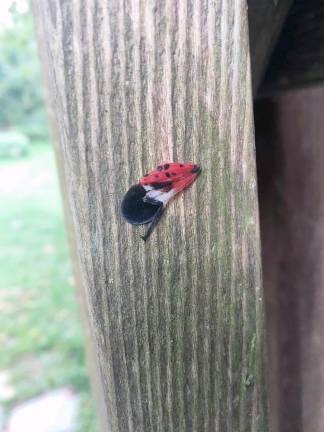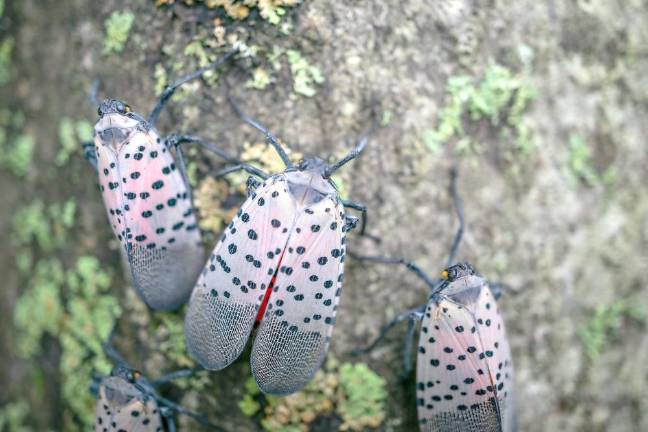Reader finds invasive spotted lanternfly in Green Township
Green Township. The New Jersey Department of Agriculture asks residents to destroy the pest and to report sightings. The spotted lanternfly spreads by hitchhiking, so vehicle checks can help stop the spread.


The invasive spotted lanternfly has landed in Sussex County. One specimen, or parts of one, was spotted by reader Linda Kabis, who took its photo on Sunday.
“Sad to find this wing/leg evidence of a spotted lanternfly stuck on my deck railing in Green Township this morning,” she said in an accompanying message.
On Aug. 12, Douglas Fisher, the New Jersey Department of Agriculture secretary, provided instructions for residents who encounter the pest, as the department continues to receive numerous calls about it.
“We are targeting areas where severe infestations have been confirmed, and we also encourage residents to destroy the spotted lanternfly if possible when they see it,” Fisher said. “It will take a combined effort to help keep this pest from spreading.”
Fisher said the spotted lanternfly does not pose a threat to humans or animals, but it is known to feed on 70 different types of plants and trees. It is native to China and South Korea, he said, but arrived in the United States in Berks County, Pa., on a shipment in 2014. The species has been advancing ever since, causing Pennsylvania to have 26 counties currently under quarantine. The New Jersey counties under quarantine are Warren, Hunterdon, Mercer, Burlington, Camden, Gloucester, Salem, and Somerset. Anyone who travels in these counties is asked to do a quick inspection of their vehicle for the spotted lanternfly before leaving.
The spotted lanternfly is a plant hopper and can only fly short distances, said Fisher. However, it is an excellent hitchhiker and has been known to ride on any kind of transportation.
“Its ability to travel easily on any mode of transportation has allowed it to spread,” said Joe Zoltowski, director of the New Jersey Department of Agriculture Plant Industry Division.
Crews treating infested areas
Fisher said his department is partnering with the U.S. Department of Agriculture’s Animal Plant and Health Inspection Service to curb the spread. Several crews throughout the state are treating areas where infestations have been reported. Those crews may seek permission to come on to a property where large infestations exist. They will have proper identification and follow proper safety protocols.
The crews will need to check only the specific areas outdoors where the spotted lanternfly has been found. Treatments will only occur on the Tree of Heaven, which the Spotted Lanternfly prefers and is believed to need to reproduce.
Since surveys and treatments for the Spotted Lanternfly in New Jersey began in 2018, there have been more than 200,000 Trees of Heaven treated on almost 19,000 acres.
Residents who would like to treat the infestations on their own property will find a list of options at https://bit.ly/3eIuTEi. Using items such as sticky traps are not recommended as they may harm other wildlife.
While the spotted lanternfly is currently in its full adult stage, it will begin laying egg masses in early to mid-September. The gray-looking egg masses can be scraped off, double bagged, and then thrown away. The egg masses can also be placed into alcohol, bleach, or hand sanitizer to kill them. An instructional video on how to destroy the egg masses is available at bit.ly/3fMIw52.
Residents outside of the quarantine counties can report the exact address of sightings of the spotted lanternfly by emailing Slf-plantindustry@ag.nj.gov or by calling 609-406-6943.